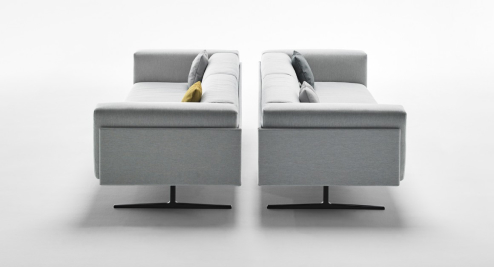

Office Productivity



Study after study shows that high-performance workplaces enable people to be productive, engaged, and happy. Research from global architecture and design firm Gensler shows that productivity can increase by 19% and job satisfaction by 79% simply by designing an engaging workplace.
Sounds easy, right? Creating a productive, high-performance office is possible, but it takes a keen focus on planning, communication, and execution.
Here are a few tips for designing an engaging workplace that will improve productivity, help your company attract and retain the best workers and impress your customers:
Create an Office that Promotes Movement

– Movement helps your body by reducing aches and pains and improving metabolism, but it can also help your mind. Prolonged sitting leads to poor blood flow. As you move throughout the day, your body can maintain optimal circulation to the brain, which is linked to improved cognitive function and productivity. Studies have shown that employees who move tend to be healthier. Increased movement can lead to improvement in motor function, attention, and even cognitive speed, all of which have the potential to impact your work performance.
Add Natural Light and Biophilic Design to Your Office

– Research by Cornell University Professor Dr. Alan Hedge proves the connection between natural light and employee wellbeing. Hedge’s recent study found that workers in office environments with plenty of light reported a 51% drop in the incidence of eyestrain, a 63% drop in the incidence of headaches, and a 56% reduction in drowsiness. Plants and improved air quality help productivity in the office as well. The Spheres, an Amazon workspace in downtown Seattle has more than 40,000 plants. Amazon’s Spheres relies on the premise that natural light, plant life, and healthy activities such as walking reduce employee stress and improve job satisfaction more so than a standard office building. The Future Workplace Employee Experience Study found that 78% of employees say access to natural light and views improves their well-being and 70% report improved work performance.
Rethink Meeting and Conference Rooms
 – Conference rooms are an office necessity, but many companies are rethinking how they are designed and used. Instead of large, formal conference rooms, many companies are turning to smaller spaces that can be used for a variety of tasks. This has the added benefit of reducing the office footprint and real estate costs for the company too. Meetings have increased in length and frequency over the past 50 years, to the point where executives spend an average of 23 hours a week in them, up from less than 10 hours in the 1960s. Smaller, more casual meeting rooms lead to shorter meetings and an increase in productivity.
– Conference rooms are an office necessity, but many companies are rethinking how they are designed and used. Instead of large, formal conference rooms, many companies are turning to smaller spaces that can be used for a variety of tasks. This has the added benefit of reducing the office footprint and real estate costs for the company too. Meetings have increased in length and frequency over the past 50 years, to the point where executives spend an average of 23 hours a week in them, up from less than 10 hours in the 1960s. Smaller, more casual meeting rooms lead to shorter meetings and an increase in productivity.
Create Spaces for Collaboration
 – Modern offices thrive on collaboration, so it is important to design collaborative spaces into your plans. The business world is naturally competitive, but an unhealthy sense of competition can hurt your company, not help it. An emphasis on creating a collaborative environment will improve your organization’s productivity and ensure that every employee can thrive. A collaborative environment can significantly improve productivity simply by eliminating wasted time. For example, studies have found that the average-knowledge worker spends 2.5 hours a day gathering information, in large part because the information they need is inaccessible or out of date. The inability to easily access people or software with the necessary knowledge or information results in even more wasted time. Salesforce.com reports that 86% of executives cite ineffective collaboration as a major contributor to business failures.
– Modern offices thrive on collaboration, so it is important to design collaborative spaces into your plans. The business world is naturally competitive, but an unhealthy sense of competition can hurt your company, not help it. An emphasis on creating a collaborative environment will improve your organization’s productivity and ensure that every employee can thrive. A collaborative environment can significantly improve productivity simply by eliminating wasted time. For example, studies have found that the average-knowledge worker spends 2.5 hours a day gathering information, in large part because the information they need is inaccessible or out of date. The inability to easily access people or software with the necessary knowledge or information results in even more wasted time. Salesforce.com reports that 86% of executives cite ineffective collaboration as a major contributor to business failures.
Making Spaces Hackable
 – Hacking is usually a concept reserved for computer nerds but creating offices that are hackable or easily reconfigured can help with productivity. As work changes and evolves quicker than it ever has, companies should consider designing offices that are hackable and able to be reconfigured on the spot, or at least in a few days’ time. Allowing workers to create an environment that can be customized based on what they are doing now is increasingly important, especially since the modern office is used in so many ways. In the morning, workers might need a collaborative team space while in the afternoon they might need privacy for heads-down work. To create a collaborative office, pick furniture that is mobile and easy to move on and consider adding mobile screens that can be rolled around the office to add privacy when needed.
– Hacking is usually a concept reserved for computer nerds but creating offices that are hackable or easily reconfigured can help with productivity. As work changes and evolves quicker than it ever has, companies should consider designing offices that are hackable and able to be reconfigured on the spot, or at least in a few days’ time. Allowing workers to create an environment that can be customized based on what they are doing now is increasingly important, especially since the modern office is used in so many ways. In the morning, workers might need a collaborative team space while in the afternoon they might need privacy for heads-down work. To create a collaborative office, pick furniture that is mobile and easy to move on and consider adding mobile screens that can be rolled around the office to add privacy when needed.
Focus on Office Flow
 – Offices should be aesthetically pleasing, but the design is about more than decorating. Clever design can and should change behavior. So, designing the right flow for a high-performing office is critical. Designers should make sure to optimize the layout and location of workstations and offices to enhance visual and physical access. Lowering panels can help create a workplace that encourages movement, collaboration, and workflow.
– Offices should be aesthetically pleasing, but the design is about more than decorating. Clever design can and should change behavior. So, designing the right flow for a high-performing office is critical. Designers should make sure to optimize the layout and location of workstations and offices to enhance visual and physical access. Lowering panels can help create a workplace that encourages movement, collaboration, and workflow.
Productivity has a lot to do with the physical office, but it can be affected by management as well. Workers not only need spaces that are high performing, but they also need supportive management. Whether you’ve implemented a top-down organizational structure or one that is more fluid, you still need effective managers and team leaders to ensure workplace efficiency. Low productivity at work can result from managers who lack the leadership to motivate employees and keep them performing at their peak standard.
Increased office productivity results from a mixture of creating spaces where workers feel comfortable and empowered, but also supported by management. Finding the right blend of high-performance space and thoughtful management can help increase productivity.
See Also:
